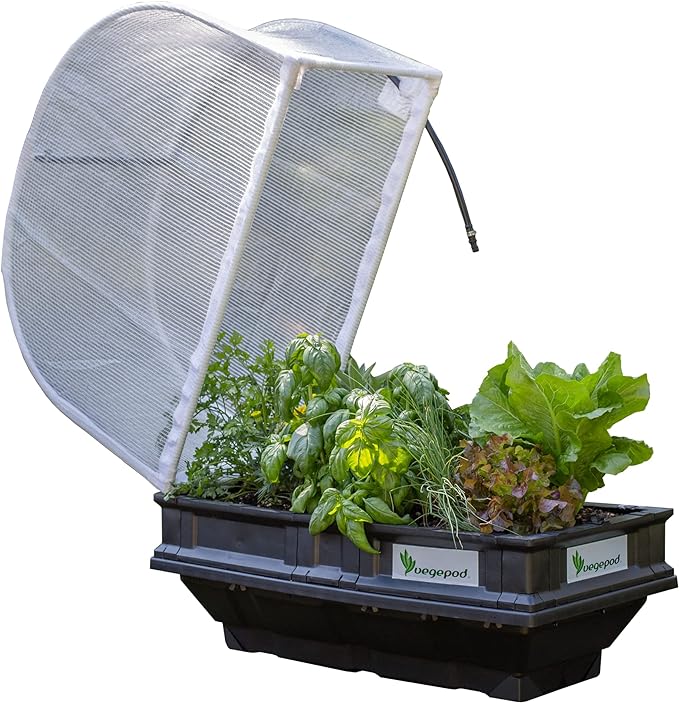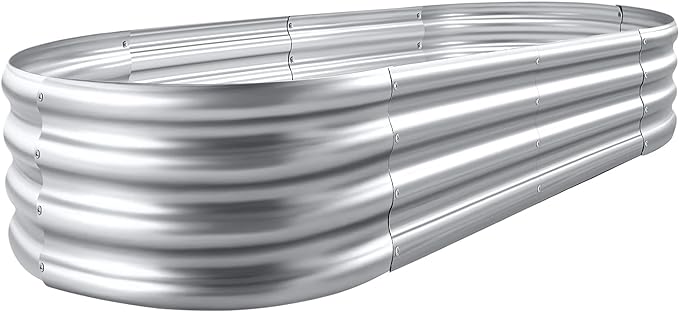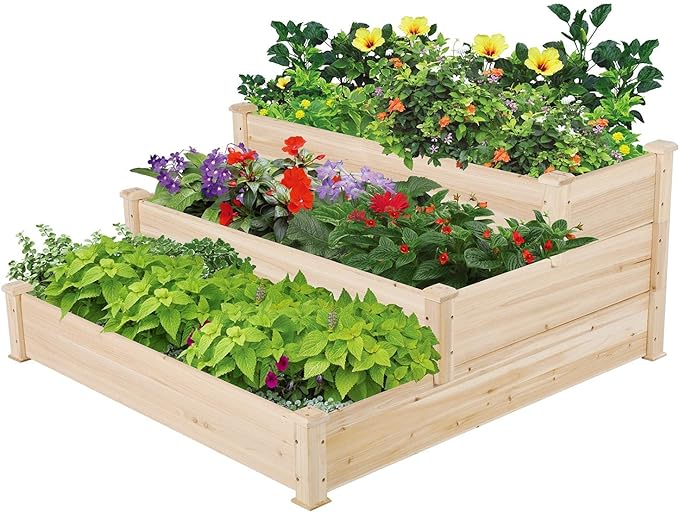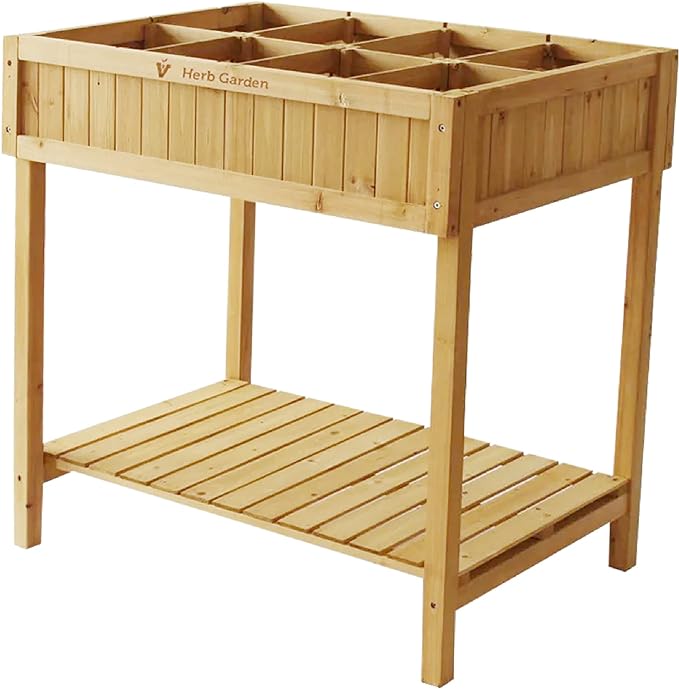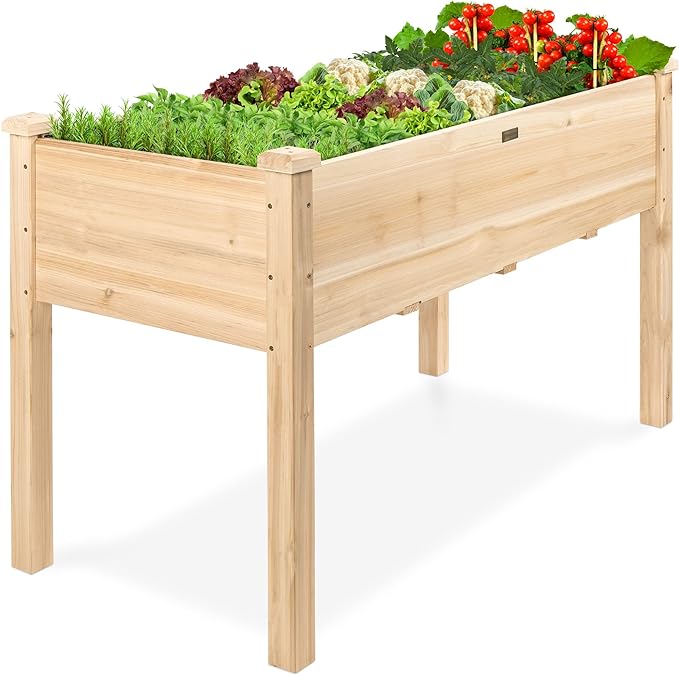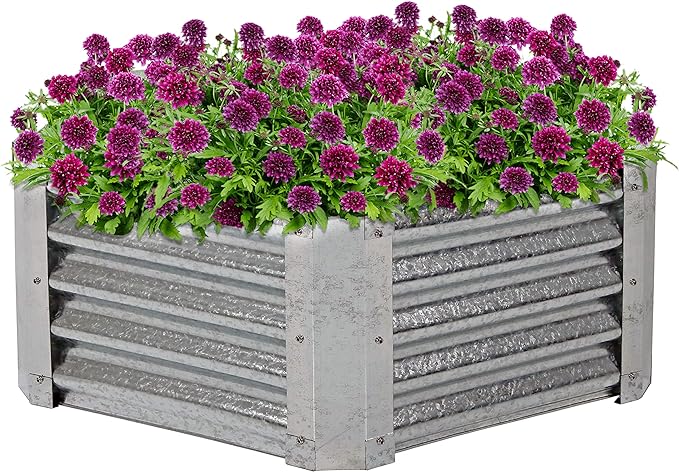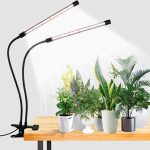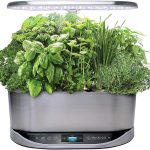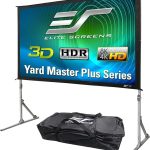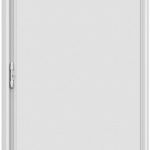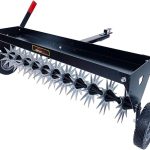When it comes to creating your ideal garden oasis, selecting the right raised garden bed is essential. You’re probably wondering, what sets the best ones apart? From self-watering systems to ergonomic designs, the top-rated options boast innovative features that’ll take your gardening game to the next level. You’ll want to explore the City Picker’s aeration screen, Vegepod’s modular design, and FOYUEE’s durable galvanized steel. But that’s just the beginning – there are seven more exceptional options waiting to be discovered. What will you find when you explore the rest of the list?
Contents
- City Picker Raised Bed Grow Box
- Vegepod Raised Garden Bed Kit
- FOYUEE Raised Planter Box with Legs Outdoor Elevated Garden Bed
- Land Guard Galvanized Raised Garden Bed Kit
- Yaheetech 3 Tier Raised Garden Bed
- VegTrug 8 Pocket Herb Garden
- Best Choice Products Raised Garden Bed
- Sunnydaze Hexagon Raised Garden Bed Kit
- Keter Easy Raised Garden Bed with Self Watering Planter
- Factors to Consider When Choosing Raised Garden Beds
- Frequently Asked Questions
- Conclusion
City Picker Raised Bed Grow Box
If you’re a city dweller with limited outdoor space, the City Picker Raised Bed Grow Box is an ideal choice, offering a mobile and self-watering gardening solution that’s perfect for patios, apartments, or fire escapes.
Made of UV-protected resin, this raised bed grow box is designed for long-term use and can be easily transported with its casters.
You’ll appreciate the self-watering system, which features a 2-gallon water reservoir and overflow holes to prevent overwatering.
The aeration screen enhances oxygen flow to plant roots, promoting faster growth, and the weed prevention system saves you time and effort.
With its space-saving design, you can grow your favorite plants in even the smallest of spaces.
Best For: City dwellers with limited outdoor space, such as those living in apartments, condos, or houses with small patios or fire escapes.
Pros:
- Mobile and self-watering unit with casters for easy transport and sun tracking
- Space-saving design ideal for small spaces, such as decks, balconies, or fire escapes
- Aeration screen enhances oxygen flow to plant roots, promoting faster growth
Cons:
- May require special potting mix and dolomite for optimal results
- Limited capacity of 1.5 cubic feet may not be suitable for large gardens
- No specific information is provided about the manufacturer’s warranty
Vegepod Raised Garden Bed Kit
The Vegepod Raised Garden Bed Kit is an ideal choice for gardeners who want to grow a variety of vegetables and plants in small spaces, such as balconies, patios, or verandahs.
With its self-watering system and protective cover, this kit ensures optimal growing conditions for your plants.
The modular design makes assembly and disassembly a breeze.
Plus, you can elevate it to 39.4 inches with the Vegepod Stand for added convenience.
With a 10-year warranty, you can have peace of mind knowing your investment is protected.
This kit is perfect for outdoor use and comes with a modern, rectangular design that fits seamlessly into any outdoor space.
You’ll be growing your favorite veggies and plants in no time!
Best For: Gardeners who want to grow a variety of vegetables and plants in small spaces, such as balconies, patios, or verandahs.
Pros:
- Easy to use and maintain, with a self-watering system that reduces watering frequency
- Suitable for small spaces, with a modular design that makes assembly and disassembly easy
- Comes with a 10-year warranty, providing peace of mind for your investment
Cons:
- Some reviewers mention issues with assembly instructions or minor design flaws
- Requires some maintenance, such as watering and pruning
- May not be suitable for indoor use, as it is designed for outdoor use
FOYUEE Raised Planter Box with Legs Outdoor Elevated Garden Bed
The FOYUEE Raised Planter Box with Legs Outdoor Elevated Garden Bed is an ideal choice for those who want to garden without the back strain, thanks to its ergonomic height that eliminates the need to bend over.
This raised garden bed is made of durable galvanized steel with an anti-rusty coating, ensuring it will last for a long time.
It’s also easy to move around, thanks to its wheels, and has a handy shelf for storing your gardening accessories.
The bed itself is spacious, holding about 2.5 cubic feet of soil, and features a drainage hole to prevent waterlogging.
With a simple 5-minute assembly process, you’ll be gardening in no time.
Best For: Gardeners who want to avoid back strain and need a portable, easy-to-assemble, and spacious elevated garden bed.
Pros:
- Ergonomic height eliminates the need to bend over, making gardening convenient
- Raised garden bed on wheels, easy to move to anywhere, with a handy shelf holds accessories
- Easy setup, taking about 5 minutes to assemble
Cons:
- Some customers mention the lack of clear instructions
- May not be suitable for large or heavy plants due to its 2.5 cubic feet capacity
- No additional features or customization options are available
Land Guard Galvanized Raised Garden Bed Kit
For those seeking a sturdy and durable raised garden bed for their outdoor space, the Land Guard Galvanized Raised Garden Bed Kit stands out with its impressive 7.14 cubic feet capacity and galvanized metal sheet construction.
You’ll appreciate the ease of assembly, which takes only about 5 minutes to set up.
The kit’s upgraded quality and structure, featuring Q195 galvanized metal sheet and double-layer anti-corrosion galvanizing, guarantee a durable and reusable garden bed.
The open base design prevents water accumulation and decay, while the double thickness of the metal sheet provides added sturdiness.
With its oval shape and floor-standing design, this kit is perfect for growing vegetables and other plants in your outdoor space.
Best For: Gardeners and outdoor enthusiasts who need a sturdy and durable raised garden bed for growing vegetables and other plants in their outdoor space.
Pros:
- Easy to assemble, taking only about 5 minutes to set up
- Made with high-quality, galvanized metal sheet construction that is durable and reusable
- Open base design prevents water accumulation and decay, ensuring a healthy growing environment
Cons:
- Some users have reported missing parts and poor customer service
- The metal sheet may be thinner than expected, which could affect its durability
- Sharp edges and corners require careful handling during assembly
Yaheetech 3 Tier Raised Garden Bed
The Yaheetech 3 Tier Raised Garden Bed is an excellent choice for those seeking a spacious and versatile gardening solution, offering ample space for cultivating a variety of plants, from vegetables to flowers and herbs.
This 3-tier design allows you to separate your plants or grow different types of plants simultaneously.
Made from natural fir wood, this bed is durable and long-lasting, with 0.6 thick solid wood boards fixed by metal hardware.
You’ll appreciate the well-sanded surface, ensuring safe use.
With a capacity of 15.06 kilograms, you can grow a substantial amount of plants.
The modern design and natural wood color will complement your outdoor space beautifully.
Best For: gardeners who want a spacious and versatile gardening solution with ample space for cultivating a variety of plants.
Pros:
- The 3-tier design allows for separation of plants or growing different types of plants simultaneously.
- The natural fir wood and metal hardware ensure durability and long-lasting use.
- The well-sanded surface ensures safe use and easy maintenance.
Cons:
- Some reviewers mentioned that the wood is fragile and prone to scratches.
- The product’s weight capacity may not be suitable for heavy soil or a large number of plants.
- The warranty information is not clearly specified.
VegTrug 8 Pocket Herb Garden
Growing multiple herbs in a compact space is made easy with the VegTrug 8 Pocket Herb Garden, perfect for outdoor use and ideal for those who want to maximize their garden’s potential without sacrificing precious space.
You’ll appreciate the durable cedar wood construction, which comes with a food-safe preservative to promote healthy root growth.
The eight individual pockets provide ample space for your herbs to thrive, and the lower shelf is perfect for storing your gardening tools and accessories within easy reach.
With a comfortable working height of 80 cm, you’ll avoid crouching while tending to your plants.
Overall, this product’s versatility, ease of assembly, and sturdy construction make it a great addition to your outdoor garden.
Best For: Gardeners who want to grow multiple herbs in a compact outdoor space without sacrificing precious space.
Pros:
- Durable cedar wood construction with a food-safe preservative to promote healthy root growth
- Ample space for herbs to thrive in eight individual pockets
- Convenient storage for gardening tools and accessories on the lower shelf
Cons:
- Some customers report issues with short screws and flimsy shelves
- May require additional protection with polyurethane for outdoor use
- Assembly may require some effort, although most customers find it easy
Best Choice Products Raised Garden Bed
The Best Choice Products Raised Garden Bed’s ergonomic 30-inch tall design reduces excessive bending and kneeling, making it an excellent choice for gardeners who need to preserve their back and knees.
This cedar wood raised garden bed provides a spacious 5CuFt of planting space, allowing your plants to breathe and grow healthy.
The design also features proper drainage, keeping the soil fresh and protecting your plants from waterlogging or mineral buildup.
The raised garden bed liner separates the wood from the soil, keeping the planter in excellent condition and discouraging weeds and animals from interfering with plant growth.
With a weight capacity of 200 lbs, you can plant a variety of herbs, vegetables, and other plants with confidence.
Best For: gardeners who need to preserve their back and knees, as well as those who want a spacious and well-designed raised garden bed for growing herbs, vegetables, and other plants.
Pros:
- Provides a spacious 5CuFt of planting space for healthy plant growth
- Ergonomic 30-inch tall design reduces excessive bending and kneeling
- Well-made and well-designed with proper drainage and a raised garden bed liner to keep the planter in excellent condition
Cons:
- May require two pairs of hands for assembly
- Material seems lightweight and may deteriorate over time
- No specific warranty information is provided
Sunnydaze Hexagon Raised Garden Bed Kit
Those seeking a durable and low-maintenance outdoor planter for their plants and vegetables will appreciate the Sunnydaze Hexagon Raised Garden Bed Kit, which boasts a sturdy corrugated rectangular galvanized steel construction.
You’ll love that it’s easy to use, with hardware and tools included to assemble the raised garden frame.
This kit promotes healthy roots with its raised bed brackets, ideal for encouraging good root development and growth.
With its silver color and traditional style, this hexagonal planter will add a touch of elegance to your outdoor space.
Measuring 36 inches wide, 40 inches long, and 16 inches tall, it’s perfect for small gardens or patios.
Best For: Gardeners and outdoor enthusiasts who want a durable and low-maintenance planter for their plants and vegetables.
Pros:
- Easy to assemble with included hardware and tools
- Promotes healthy root development and growth with raised bed brackets
- Durable and weather-resistant corrugated galvanized steel construction
Cons:
- Some customers found assembly difficult due to misaligned holes
- May require longer screws or alternative fastening method
- Limited to outdoor use and may not be suitable for large gardens
Keter Easy Raised Garden Bed with Self Watering Planter
The Keter Easy Raised Garden Bed with Self Watering Planter is an excellent choice for people with disabilities or the young at heart.
Its ergonomic design and ease of use make it a great option. The self-watering feature prevents root decay and overwatering, and the water gauge indicates when plants need more moisture.
The easy drainage system with a plug gives you full control over watering. With a capacity of 31.7 gallons, this 44.9′ x 19.4′ x 29.8′ bed is perfect for growing vegetables, herbs, or flowers.
Assembly is a breeze, and you can use it indoors or outdoors. Weighing 29.6 pounds, it’s lightweight and easy to move around.
Best For: People with disabilities, the young at heart, and anyone looking for a low-maintenance and easy-to-use raised garden bed.
Pros:
- Ergonomic design for ease of use
- Self-watering feature prevents root decay and overwatering
- Easy drainage system with a plug for full control of watering
Cons:
- No information available on warranty and support
- Assembly required, although it is considered simple
- Only one negative review out of 818 ratings, but the specific issue is not specified
Factors to Consider When Choosing Raised Garden Beds
When you’re selecting a raised garden bed, you’ll want to guarantee several key factors to confirm you choose the right one for your needs.
You’ll need to think about the type of material that’s best for you, how much space you have available, and how you’ll handle drainage and watering.
Material Selection
With numerous options available, you’re likely wondering which material is best suited for your raised garden bed, considering factors such as durability, maintenance, and aesthetic appeal.
Cedar wood is a popular choice due to its natural resistance to rot and insects, durability, and attractive appearance.
If you’re looking for a low-maintenance option, metal raised beds made from galvanized steel or aluminum might be the way to go. They’re durable and can be more affordable than wooden options, but keep in mind they can heat up in direct sunlight.
If you’re on a budget, plastic raised beds are a lightweight and affordable option. However, they may not be as durable and can degrade over time.
Composite materials, such as recycled plastic and wood fibers, offer a durable, low-maintenance, and eco-friendly option, but may be more expensive.
If you’re looking for a sustainable and budget-friendly option, consider using recycled materials like reclaimed wood or repurposed containers. Just be aware that they may require more maintenance and have a shorter lifespan.
Space and Mobility
As you plan your raised garden bed, consider the footprint it will occupy in your yard or patio, taking into account the mature size of the plants you’ll be growing. Measure the space where you plan to place the raised bed to confirm it fits comfortably, leaving enough room for easy access and maintenance.
You don’t want to be squeezing past the bed every time you need to water or harvest.
If you need to move the raised bed to different locations or store it during the off-season, look for lightweight and portable options with wheels or handles for easy transport.
Consider any obstacles, such as trees or slopes, that may impact the placement and mobility of the raised garden bed.
If you have limited mobility or plan to use the raised bed in a location that’s difficult to access, consider a raised bed with a lower profile or adjustable height to accommodate your needs.
Drainage and Watering
Proper drainage and watering systems are essential components of a well-designed raised garden bed, and you’ll want to weigh these vital factors when selecting the perfect bed for your needs.
When it comes to drainage, look for features like drainage holes and water reservoirs that maintain ideal moisture levels and prevent waterlogged soil. This is essential, as waterlogged soil can lead to root rot and other plant diseases.
Self-watering planters with built-in water gauges can also be incredibly useful, as they indicate when plants need additional moisture, reducing the risk of overwatering.
You should also consider the material of the raised bed. Corrugated galvanized steel, for instance, provides good drainage and aeration, promoting healthy root growth and preventing water accumulation.
Elevated planters with easy drainage systems can also prevent root decay and overwatering, reducing the risk of plant disease.
Ultimately, a well-designed raised garden bed should strike a balance between drainage and watering features, ensuring plants receive the right amount of moisture. By considering these factors, you can create an ideal environment for your plants to thrive.
Assembly and Maintenance
When selecting a raised garden bed, you’ll need to weigh the time and effort required for assembly and maintenance, as some models demand more of your sweat and skill than others.
Assembly requirements vary greatly, with some beds needing only simple tools and others requiring more complex assembly with multiple parts.
If you’re not DIY-savvy or have mobility issues, look for products with easy-to-follow instructions to make assembly a breeze.
Maintenance is another vital factor in the decision-making process.
Features like self-watering systems can simplify tasks like watering, while ergonomic designs can reduce strain on your back and knees.
The material and construction of the raised bed also impact maintenance needs.
For instance, wooden planters might require more upkeep than metal or plastic alternatives.
Regular cleaning and inspection of the raised bed can help prevent issues like waterlogging and pests, ensuring a healthy and thriving garden.
Ergonomic Design
By incorporating ergonomic design principles into your raised garden bed, you’ll be able to work comfortably, reducing the strain on your back and knees while gardening.
A well-designed raised bed can make all the difference, especially for those with mobility issues or chronic pain.
Aim for a bed height of around 30-40 inches, which allows you to stand comfortably while working, eliminating the need for bending or kneeling.
This ergonomic design won’t only reduce fatigue and discomfort but also enhance your overall gardening experience. You’ll be able to work for longer periods without strain, enjoying the therapeutic benefits of gardening.
In addition, ergonomic design can improve accessibility for gardeners with disabilities, enabling them to participate in gardening activities with greater ease.
Plant Capacity and Growth
When selecting a raised garden bed, several key factors can profoundly impact plant capacity and growth.
One vital aspect is soil depth, as it affects root development and overall plant health. Deeper beds allow for more extensive root systems, potentially leading to larger harvests.
The type and quality of soil used also play a significant role, with well-draining and nutrient-rich soils promoting healthy plant development.
Proper plant spacing and arrangement within the raised bed are essential as well. Adequate air circulation, sunlight penetration, and access to water and nutrients are all critical for ideal growth.
Finally, the choice of plants themselves can impact growth, with some varieties being more suitable for raised beds than others due to factors like mature size, growth habits, and soil preferences.
Budget and Value
Determine your budget and calculate the cost per square foot of gardening space, as prices for raised beds can range from $1 to $10 per square foot, depending on the material and quality of the bed. This calculation will help you make an informed decision when choosing a raised garden bed that fits your budget.
While a higher upfront cost might seem intimidating, consider the long-term value of a durable and well-made raised bed. It may require less maintenance and replacement over time, ultimately saving you money and hassle. Additionally, some raised beds come with features like self-watering or aeration, which can increase their overall value and justify a higher initial investment.
Don’t forget to factor in the cost of additional accessories or tools you’ll need, such as soil, seeds, or gardening utensils, when calculating your total budget. Finally, compare prices and features across different products and brands to find the best value for your specific needs and budget. By doing your research and considering these factors, you’ll be able to find a raised garden bed that meets your budget and meets your gardening needs.
Frequently Asked Questions
Can I Use Raised Garden Beds on a Balcony or Patio?
You can definitely use raised garden beds on a balcony or patio, as long as you choose a compact design and consider weight capacity, sunlight, and wind exposure to promote a thriving mini-garden.
Are Raised Garden Beds Suitable for People With Back Problems?
Since you’re considering gardening with back problems, you’ll be relieved to know that raised beds are a great option, allowing you to garden at a comfortable height, reducing strain and discomfort, and making it easier to maintain.
How Often Should I Water My Raised Garden Bed Plants?
As you tend to your garden, remember that life-giving water is like nourishing rain, quenching the thirst of your plants. You should water your raised bed plants when the top 2-3 inches of soil feel dry to the touch, usually every 2-3 days in warm weather.
Can I Grow Vegetables in a Raised Garden Bed Year-Round?
You can grow veggies year-round in a raised bed, but it depends on your climate and the types of vegetables you’re planting. In warmer areas, you can plant cool-season crops in winter and warm-season ones in summer.
Do I Need to Line the Bottom of My Raised Garden Bed?
You’re wondering if you need to line the bottom of your raised garden bed. Yes, you should, as it prevents weeds and pests from growing up, reduces soil erosion, and makes maintenance easier for you.
Conclusion
You’ve got the green thumb and the perfect spot – now it’s time to pick the ideal raised garden bed for your budding garden!
With so many great options, you’re spoiled for choice.
From self-watering wonders to ergonomic designs, the perfect bed is out there waiting.
Take a deep breath, get digging, and let your garden dreams take root!

